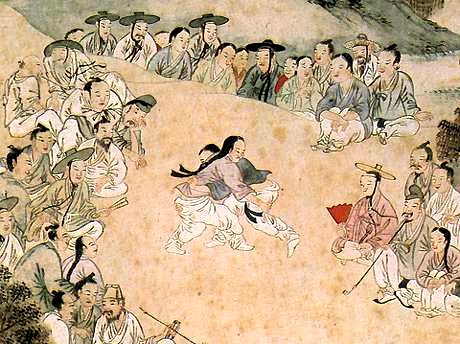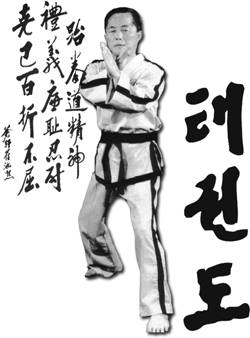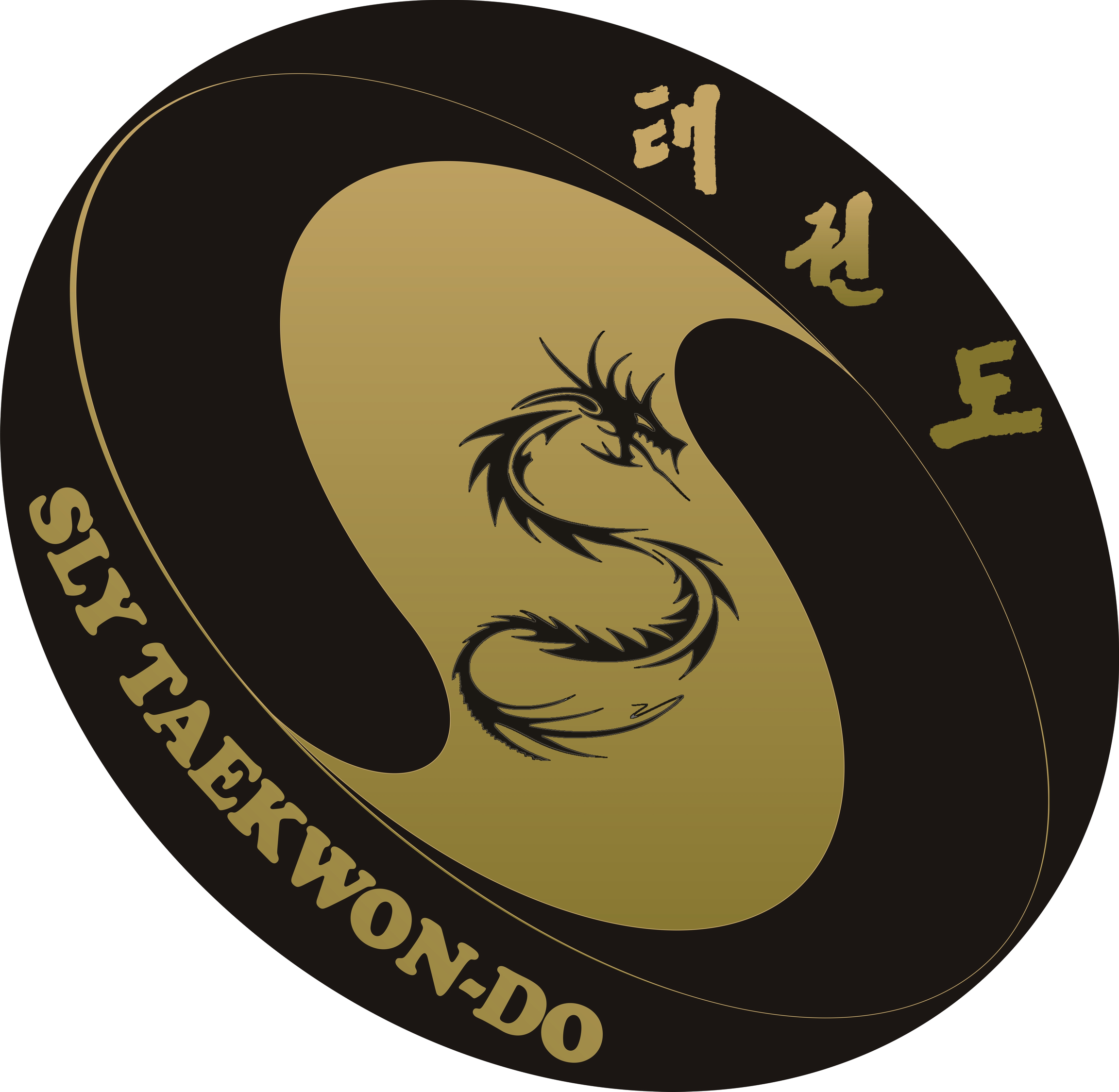History of Taekwon-do (Taekwon-do Yoksa) - Taekwon-do Yoksa
 In the VII-VIII. century different self defence and martial schools increased en masse in Silla and Koguryo whose popularity upswept for long time. Nevertheless the sequential (sceptred) dynasties gradually started to fear that not only their own warriors but civilian people could get insight into the „top secret” combat technics. They feared that people in case of an incidental revolt might use this knowledge against them that's why they rolled back the functioning of the scools gradually.
In the VII-VIII. century different self defence and martial schools increased en masse in Silla and Koguryo whose popularity upswept for long time. Nevertheless the sequential (sceptred) dynasties gradually started to fear that not only their own warriors but civilian people could get insight into the „top secret” combat technics. They feared that people in case of an incidental revolt might use this knowledge against them that's why they rolled back the functioning of the scools gradually.
The medieval rulers restricted the earlier free weapon keeping increasingly. Finally there were some rulers who forbade the practice of the „dangerous” freehand fight for everyone except the professional solders.
This way, in certain periods could spread only isolatedly and its knowledge came down from father to son as a „family secret”. It is the reasons that nowadays the once famous and great considerable martial schools remain already in fragments in Korea.
For the Korean martial arts the next aching stroke was the Japan oppression, which took from 1909 to 1945. During this 36 years the invaders banned the practice of all the martial arts. All the same there were once resoluted masters at many different places in Korea who kept practicing the TAEK KYON and SOO BAK GI technics with their students stealthily. Among others, thanks to such a prominent instructors as Song Duk Ki and Han Il Dong that these aboriginal cultural legacies could survive the hard years of the occupation.
Korea was liberated in 1945 and the new republican army was founded on fifteenth of January, 1946. This time an extremely talented and forceful gong officer started to teach some of his soldiers the new art of the new way of self defence and martial arts that he had created.
The officer's name was Choi Hong Hi who was sentenced to prison for seven years by the Japanese for the involvement in the Korean independence front in 1944. However, the August of 1945 brought not only the long desired freedom for the Korean nation but for Choi Hong Hi too, who was imprisoned. Next he became a member of the new army' upper-deck ratings and at his station he started the organised training of the Taekwon-do between the units that were under his command. From this time the founder's name of the modern Taekwon-do Choi Hong Hi tightly interlocked with the history of Taekwon-do.
Choi Hong Hi founder's curriculum vitae
 Choi Hong Hi founder grandmaster (from the end of the '50s he was one of the Korean army's leaders as lieutenant-general, in after years he was diplomat of high rank later he was ambassador too) was born in Ha Dae that is famous for his romantic land in Myong Chun Kun province in the modern Nortn Korea in 1918. He spent his childhood in his parents' house. His parents tried to make their son have many accomplishments and he was tought by the most prominent teachers. As a child he came through lots of child illnesses and his family worried a lot about his health condition. To compensate this he started to practice free exercises and acrobatics. He learned in the first year of the primary school when his father took him to his good old friend Han Il Dong. Han tought the Korean calligraphy but at the same time he was a famous master of the aboriginal martial art: Taek Kyon too. Then the boy who was clever and recipient for everything was introduced into the mystery of the sport. Choi started the daily trainings with extra fanaticism and diligence and he did the multiple of the stints day by day.Shortly it had been the achievement: his body strengthened and he recovered from health problems for good.
Choi Hong Hi founder grandmaster (from the end of the '50s he was one of the Korean army's leaders as lieutenant-general, in after years he was diplomat of high rank later he was ambassador too) was born in Ha Dae that is famous for his romantic land in Myong Chun Kun province in the modern Nortn Korea in 1918. He spent his childhood in his parents' house. His parents tried to make their son have many accomplishments and he was tought by the most prominent teachers. As a child he came through lots of child illnesses and his family worried a lot about his health condition. To compensate this he started to practice free exercises and acrobatics. He learned in the first year of the primary school when his father took him to his good old friend Han Il Dong. Han tought the Korean calligraphy but at the same time he was a famous master of the aboriginal martial art: Taek Kyon too. Then the boy who was clever and recipient for everything was introduced into the mystery of the sport. Choi started the daily trainings with extra fanaticism and diligence and he did the multiple of the stints day by day.Shortly it had been the achievement: his body strengthened and he recovered from health problems for good.
Though he was smaller than the children at this age in a little while he started to excel of his fellow not only by his intelligence but his physical abilities. In braveness and hardness however he surpassed all of them. After a comperatively short training time he made good use of his cat-like flexibility that he got in gymnastics and his inherited looseness. (Choi has been able to slip down the splitts witout all kinds of warming-up exercises even today…) Evidently it could be seen at the beginning (fore-part) that he was in possession of talent in martial arts.
By the age of 11 he increased his „arsenal” with breath-taking kicking and acrobatical elements and as he didn't find suitable opponent among children he started to practice with adults. When he was 12 he got the 1st Dan degree of black belt! He was the first in the world who applied the present-day Taekwon-do offensive style in such a way featured one-legged (or same-legged) kick-sequences in pursue sports. It looked like taking up a place in fighting stance continously with a spring in his move he lifted up his first leg and without touching the floor and bide his time he was able to place 10-15 kicks on his opponent with the same leg with fantastic quickness. When he demonstrated he inserted some especially hard (made by himself) rotating or from one jump started kicks even more sometimes from a somersault executed jumping kick too! Taking his complex and varied hand techniques into consideration the respect and admiration can be imagine that was produced from opponent and public for such a combat manner could.
Choi Hong Hi's formerly best students (the present day's grandmasters) copy his movement all and the world's Taekwon-do's competing leaders also try to bring this technical style in fight.
The founder already in his youth belonged to those very few in numbers who combined this magnificent ability with exceptional working capacity and resoluteness. He knew accurately what he wanted and he was able to subordinate everything to this set aim. Year by year almost every day of the week he practiced 9-10 hours. He repeated a movement several hundreds of thousands of time for long months until he would be master of the technic. Through his particular practice method he obtained perfect inner harmony. His decision to be the best in Korea finally came true.
After he acquired the Tae Kyon as a master in his country in 1937, he went to Japan at the age of 19 to start his higher education. In Kyoto and Tokyo he got college and university degree parallel to each other (and after liberation he degreed military academy in English language in Seoul). From autumn of 1937 at a Korean grandmaster, who lived in Japan (who led „korean karate” named school in Kyoto) after the daily studying, he practiced hard the other ancient national martial art Soo Bak Gi in the evenings. During the years he continuously got the high Dan degrees. And during the years that he spent in the island he observed, got more other Japanese and chinese tendencies. He had possibility to analyse these carefully and compare them to the popular korean forms. He got acquainted with more legendary Japanese masters of karate personally, thus, for example with Gichin Funakoshi, too. Sometimes he visited the still young and active karate celebrities' schools with pleasure and he fought lot with them according to the local rules. Choi achieved himself great respect among the Japanese karates with his special technical knowledge combined with modest behaviour. He was attached with sincere friendship to Masutatsu Oyama who also studied in Japan too at that time and who related to him (he was the Koran birth founder of kyokushinkai karate) whose original family name was otherwise Choi Young…
Founding and developing of Taekwon-do
First of all in Korea acquired Taek Kyon and in Japan practiced Soo Bak Gi techniques became the starting-points of the new martial art's movement was named by the founder „Taekwon-do” and was found in the 1940 years. The reason why they were only starting-points that Choi Hong Hi was never satisfied with the techniques learnt earlier and he unceasingly searched for the better, the more perfect. Meanwhile he reaced the realization that all of the fighting system that he had studied had deficiency and if he wanted to step forward he had to found a radically new style, which met the requirements and spirit of the new age!
Choi Hong Hi - although he used the techniques learnt earlier too - was given a clue by the carefully studied anatomical and physical regularities to such a new solution as outcome would be the modern Taekwon-do. In technical line Choi was extraordinarily critical moreover he was sceptical in contrast to the so-called „traditions”. He didn't accept as argument that a motion or technical element „had to t do with the same method because the older had had done it the same way”... The badly explained respect of tradition he thought the breaker of the technical plane. He started from the simple philosophical basic idea that there couldn't be absolutely perfectly created system! This also could be approached only theoretically. Since the knowlegde and the science developed and changed continously in accordance with this methods and the principles had to change too. It was a right idea to revalue and revise all the passed way occasionally and if it was neccessary change it with right professional thoroughness. It could come into being only continous searching of path and was taken up with scholarly research work!
By 1946 predominantly he finished his great work and once and for all started to crystallize the modern Teakwon-do's new, overall system. „Tul”-s were born as the own patterns of Taekwon-do. Finally Choi utilized only about 20 per cents the techniques of Taek Kyon and Soo Bak Gi and 80 per cents he created radically new and really his own „product”. The genius of the founder is proved unambiguously for instance with the facts that he was able to create almost one hundred such kicks planned by himself, like flying kicks, punches and defense elements in Taekwon-do that neither the former Korean tendencies or the diverse Chineseor Japanese styles hadn't used earlier. Besides it could be estimated the number of the tecniques at more hundred that were similar though could be found elsewhere too but not in such form and approach or not such scholarly method and thoroughness as Choi Hong Hi grandmaster made up these for Taekwon-do. Finally to the most cardinal point of disparity from the other fighting style was not „what” but „how”. Totally modern and unique solution together with the sudden improvement of the quality would be typical to all the own created or just overtaken techniques from the other styles. He placed the principles of the instruction of the fundamental exercises and the motion system on brand-new and wholly scholarly bases. He was helped by the physical regularity, the dynamics sing, the statics sing as well as mathematics sing and aesthetics sing and finally but not last anatomy.
Considering the fact that Choi as field-officerand later as general, ran a shining military career in the new Korean army in the years that followed the liberation it was almost lowful that Taekwon-do was tought first in the Korean army as one of the most effective device of the military training and education. In 1947-48 the founder with his most clever students participation popularized the new and spectacular sport on long demonstration rounds everywhere in Korea. It followed in 1949 the first big success foreign demonstration series in the USA. Since 1949 Taekwon-do spread in Korea and started to giant upswing. In 1955 The Korean Taekwon-do Federation was established with Choi Hong Hi's presidency and the new self-defence and martial art was accepted by the government as officially supported national sport of the country in the same year. In the next decade Takwon-do reached almost all country of the world and the local federations were founded.
